Cellular slime mold - Study guides, Class notes & Summaries
Looking for the best study guides, study notes and summaries about Cellular slime mold? On this page you'll find 61 study documents about Cellular slime mold.
Page 3 out of 61 results
Sort by

-
Mcb 3020 Exam Questions With Verified Solutions
- Exam (elaborations) • 4 pages • 2024
-
- $10.49
- + learn more
Mcb 3020 Exam Questions With Verified Solutions A microbe is discovered living in an extreme environment near a deep sea vent. The microorganism lacks a nucleus and peptidoglycan in its cell wall, but it does have unusual membrane lipids. This species is most likely a member of the Domain - answerArchaea Disproves spontaneous generation - answerLouis Pasteur Generates the small pox vaccine - answerEdward Jenner Describes bacterial transformation - answerFredrick Griffith Determined the s...

-
Clemson Microbiology 3050 Exam 1 with verified solutions.
- Exam (elaborations) • 16 pages • 2024
-
- $14.49
- + learn more
Microorganism Organisms and acellular entities too small to be seen clearly by an unaided eye; =<1mm in diameter often unicellular Cellular Fungi (yeasts + molds) protists (algae, protozoa, slime molds) bacteria (E. coli) Archaea (methanogens) Brainpower Read More Previous Play Next Rewind 10 seconds Move forward 10 seconds Unmute 0:00 / 0:15 Full screen Acellular Viruses (protein + nucleic acids) Viroids (RNA) Satellites (Nucleic Acid + RNA) Prions (inf...

-
Brooks Biological Principles Exam 3 Questions and Answers
- Exam (elaborations) • 31 pages • 2024
- Available in package deal
-
- $13.49
- + learn more
Brooks Biological Principles Exam 3 Questions and Answers Mitosis - Answer- • the duplication and division of the nucleus • results in clones with *no* variation or adaptation • takes place in somatic cells (non-sex cells) • starts with one cell and creates 2 identical daughter cells • replicated chromosomes are evenly divided so that each daughter cell receives a complete set (46 chromosomes) • *can occur by itself*, but usually involves cytokinesis • not synonymous with ...
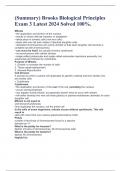
-
(Summary) Brooks Biological Principles Exam 3 Latest 2024 Solved 100%.
- Summary • 20 pages • 2024
- Available in package deal
-
- $14.49
- + learn more
(Summary) Brooks Biological Principles Exam 3 Latest 2024 Solved 100%. Mitosis • the duplication and division of the nucleus • results in clones with no variation or adaptation • takes place in somatic cells (non-sex cells) • starts with one cell and creates 2 identical daughter cells • replicated chromosomes are evenly divided so that each daughter cell receives a complete set (46 chromosomes) • can occur by itself, but usually involves cytokinesis • not synonymous with ...

-
Mcb 3020 Exam Questions With Verified Solutions
- Exam (elaborations) • 4 pages • 2024
-
- $10.49
- + learn more
Mcb 3020 Exam Questions With Verified Solutions A microbe is discovered living in an extreme environment near a deep sea vent. The microorganism lacks a nucleus and peptidoglycan in its cell wall, but it does have unusual membrane lipids. This species is most likely a member of the Domain - answerArchaea Disproves spontaneous generation - answerLouis Pasteur Generates the small pox vaccine - answerEdward Jenner Describes bacterial transformation - answerFredrick Griffith Determined the s...
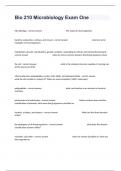
-
Bio 210 Microbiology Exam One Complete Questions And Answers 100% Verified.
- Exam (elaborations) • 21 pages • 2024
-
Available in package deal
-
- $12.99
- + learn more
Microbiology - correct answer The study of microorganisms bacteria, eukaryotes, archaea, and viruses - correct answer what are some examples of microorganisms metabolism, growth, reproduction, genetic variation, responding to stimuli, and internal homeostasis - correct answer what are some common features that living organisms share the cell - corr...
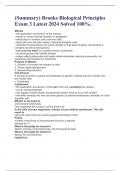
-
(Summary) Brooks Biological Principles Exam 3 Latest 2024 Solved 100%.
- Summary • 20 pages • 2024
-
- $9.49
- + learn more
(Summary) Brooks Biological Principles Exam 3 Latest 2024 Solved 100%. Mitosis • the duplication and division of the nucleus • results in clones with no variation or adaptation • takes place in somatic cells (non-sex cells) • starts with one cell and creates 2 identical daughter cells • replicated chromosomes are evenly divided so that each daughter cell receives a complete set (46 chromosomes) • can occur by itself, but usually involves cytokinesis • not synonymous with ...
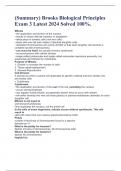
-
(Summary) Brooks Biological Principles Exam 3 Latest 2024 Solved 100%.
- Exam (elaborations) • 20 pages • 2024
-
- $14.59
- + learn more
(Summary) Brooks Biological Principles Exam 3 Latest 2024 Solved 100%. Mitosis • the duplication and division of the nucleus • results in clones with no variation or adaptation • takes place in somatic cells (non-sex cells) • starts with one cell and creates 2 identical daughter cells • replicated chromosomes are evenly divided so that each daughter cell receives a complete set (46 chromosomes) • can occur by itself, but usually involves cytokinesis • not synonymous with ...
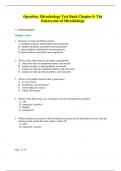
-
OpenStax Microbiology Test Bank Chapter 5: The Eukaryotes of Microbiology
- Exam (elaborations) • 14 pages • 2024
-
- $15.89
- + learn more
OpenStax Microbiology Test Bank Chapter 5: The Eukaryotes of Microbiology * = Correct answer Multiple Choice 1. Protozoa are best described as being: A. nonphotosynthetic multicellular microorganisms B. nonphotosynthetic unicellular microorganisms* C. photosynthetic multicellular microorganisms D. photosynthetic unicellular microorganisms 2. Which of the following best describes zooplankton? A. eukaryotes that are nonphotosynthetic and motile* B. eukaryotes that are photosynthet...

-
Test Bank for Prescott's Microbiology, 12th Edition by Joanne Willey || All Chapters || Updated Version A+
- Exam (elaborations) • 796 pages • 2024
-
- $14.99
- + learn more
Test Bank for Prescott's Microbiology, 12th Edition by JoanneWilleyPrescott's Microbiology, 12e (Willey) Chapter 1 The Evolution of Microorganisms and Microbiology 1) Archaea are cellular organisms that have unique cell membrane . Answer: lipids Topic: Archaea Bloom's/Accessibility: 1. Remember / Keyboard Navigation ASM Topic: Module 02 Cell Structure and Function ASM Objective: 02.03 Bacteria and Archaea have specialized structures (e.g. flagella, endospores, and pili) that often confer c...

That summary you just bought made someone very happy. Also get paid weekly? Sell your study resources on Stuvia! Discover all about earning on Stuvia


